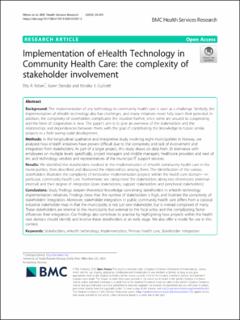| dc.contributor.author | Nilsen, Etty Ragnhild | |
| dc.contributor.author | Stendal, Karen | |
| dc.contributor.author | Gullslett, Monika Knudsen | |
| dc.date.accessioned | 2020-05-12T08:59:20Z | |
| dc.date.available | 2020-05-12T08:59:20Z | |
| dc.date.created | 2020-05-11T15:16:19Z | |
| dc.date.issued | 2020 | |
| dc.identifier.citation | Nilsen, E.R., Stendal, K. & Gullslett, M.K. (2020). Implementation of eHealth Technology in Community Health Care: the complexity of stakeholder involvement. BMC Health Serv Res 20, 395. https://doi.org/10.1186/s12913-020-05287-2 | en_US |
| dc.identifier.issn | 1472-6963 | |
| dc.identifier.uri | https://hdl.handle.net/11250/2654021 | |
| dc.description.abstract | Background: The implementation of any technology in community health care is seen as a challenge. Similarly, the implementation of eHealth technology also has challenges, and many initiatives never fully reach their potential. In addition, the complexity of stakeholders complicates the situation further, since some are unused to cooperating and the form of cooperation is new. The paper’s aim is to give an overview of the stakeholders and the relationships and dependencies between them, with the goal of contributing this knowledge to future similar projects in a field seeing rapid development.
Methods: In this longitudinal qualitative and interpretive study involving eight municipalities in Norway, we analysed how eHealth initiatives have proven difficult due to the complexity and lack of involvement and integration from stakeholders. As part of a larger project, this study draws on data from 20 interviews with employees on multiple levels, specifically, project managers and middle managers; healthcare providers and next of kin; and technology vendors and representatives of the municipal IT support services.
Results: We identified the stakeholders involved in the implementation of eHealth community health care in the municipalities, then described and discussed the relationships among them. The identification of the various stakeholders illustrates the complexity of innovative implementation projects within the health care domain—in particular, community health care. Furthermore, we categorised the stakeholders along two dimensions (external– internal) and their degree of integration (core stakeholders, support stakeholders and peripheral stakeholders).
Conclusions: Study findings deepen theoretical knowledge concerning stakeholders in eHealth technology implementation initiatives. Findings show that the number of stakeholders is high, and illustrate the complexity of stakeholders’ integration. Moreover, stakeholder integration in public community health care differs from a classical industrial stakeholder map in that the municipality is not just one stakeholder, but is instead comprised of many. These stakeholders are internal to the municipality but external to the focal actor, and this complicating factor influences their integration. Our findings also contribute to practice by highlighting how projects within the health care domain should identify and involve these stakeholders at an early stage. We also offer a model for use in this
context. | en_US |
| dc.language.iso | eng | en_US |
| dc.rights | Navngivelse 4.0 Internasjonal | * |
| dc.rights.uri | http://creativecommons.org/licenses/by/4.0/deed.no | * |
| dc.title | Implementation of eHealth Technology in Community Health Care: the complexity of stakeholder involvement | en_US |
| dc.type | Peer reviewed | en_US |
| dc.type | Journal article | en_US |
| dc.description.version | publishedVersion | en_US |
| dc.rights.holder | © The Author(s). 2020 | en_US |
| dc.source.pagenumber | 13 | en_US |
| dc.source.volume | 20 | en_US |
| dc.source.journal | BMC Health Services Research | en_US |
| dc.identifier.doi | 10.1186/s12913-020-05287-2 | |
| dc.identifier.cristin | 1810358 | |
| cristin.ispublished | true | |
| cristin.fulltext | original | |
| cristin.qualitycode | 2 | |

